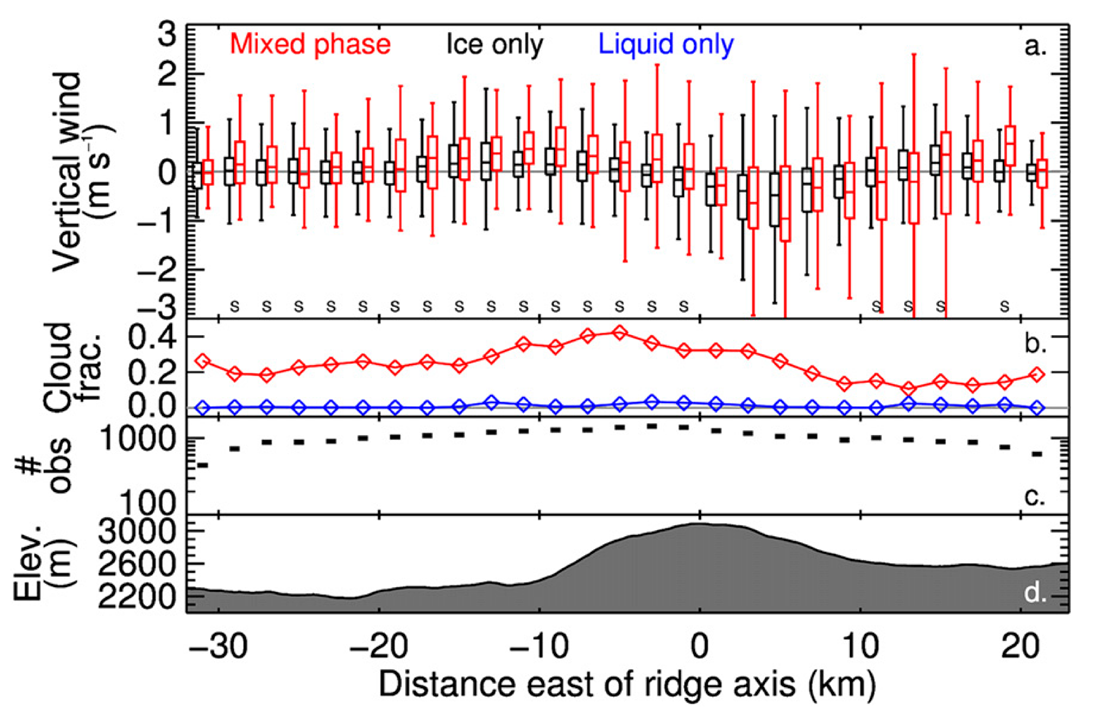Mountain-induced dynamics influence cloud phase distribution and precipitation
Submitter:
Shupe, Matthew — University of Colorado
Area of research:
Cloud Processes
Journal Reference:
Science
The spatial distribution of snowfall in relation to a mountain range is important for climatological basin-scale hydrology, water resource management, and ski enthusiasts alike. Ultimately this distribution depends on cloud formation processes that are driven by complex orographic dynamics. In addition, cloud phase can be an important control on the production and distribution of precipitation.
The general complexities of this orographic-dynamic-multiphase-precipitation system have been a challenge to represent adequately in numerical models. This subject was explored during the winter of 2010-2011 via coordinated projects targeting clouds, precipitation, and dynamics in the Park Range of Colorado. The National Science Foundation sponsored aircraft measurements as part of the Colorado Airborne Multi-Phase Study in coordination with the DOE ARM Facility's Storm Peak Cloud Properties Validation Experiment (STORMVEX). Observations from this joint campaign during 10 frontal and post-frontal storms were examined to explore transitions in the structure of clouds and dynamics relative to a significant north-south mountain barrier with largely unobstructed western fetch.
Impact
In a series of transects at multiple heights, the University of Wyoming King Air made in situ cloud microphysics and air motion measurements while simultaneously profiling below the aircraft with cloud radar and lidar. Flight-level cloud measurements characterized the total cloud water content and its partitioning by phase, along with ice-particle number concentrations. These aircraft measurements were put in context using atmospheric stability analyses based on radio-soundings launched from the valley floor just upwind of the mountain range. A composite analysis was conducted by combining all observations from along-wind transects during 10 aircraft flight cases with predominant westerly flow impinging on the mountain barrier.
Composite transect statistics of flight-level observations showed median vertical winds to be mostly upward at a distance of about 10 km upwind of the mountain ridge axis, with maxima in cloud total water content and ice-particle number concentration near the ridge axis. Mixed-phase clouds were found throughout the study domain, but increased in frequency by 70% relative to other cloud types in the vicinity of the mountain barrier. Compared to ice-only clouds, mixed-phase clouds were associated with greater near-ridge increases in total water content and preferentially occurred in regions with greater vertical wind variability and/or stronger updrafts, depicted in the image. Strong lee-side reductions in total water content, the fractional occurrence of mixed-phase clouds, and the ice particle number concentration reflect the dominance of precipitation and particle mass loss processes, rather than cloud growth processes, downwind from the topographic barrier. When stability in the air column did not support subsidence in the mountain lee, the spatial cloud and dynamical pattern was markedly different, with both ice- and liquid-water-bearing clouds appearing near the ridgeline and extending downwind. Cases supporting trapped lee waves showed downwind mixed-phase clouds occurring near the peaks of these waves.
Summary
These 10 cases together provide a composite characterization of how mountain-forced dynamics influence local cloud and precipitation formation while also revealing the case-to-case variability associated with differences in atmospheric stability, moisture supply, and wind directions. Future research can further leverage these measurements to examine the causes and impacts of vertically—versus horizontally—propagating mountain waves, in addition to other processes. In support of STORMVEX, these aircraft spatial measurements offer key context for interpreting ground-based measurements of cloud structures while also serving as in situ validation data for comparison with remote-sensing cloud microphysics retrievals. Finally, information on processes controlling the spatial distribution of precipitation is critical for many stakeholders that are keenly interested in hydrology of the Mountain West region.


